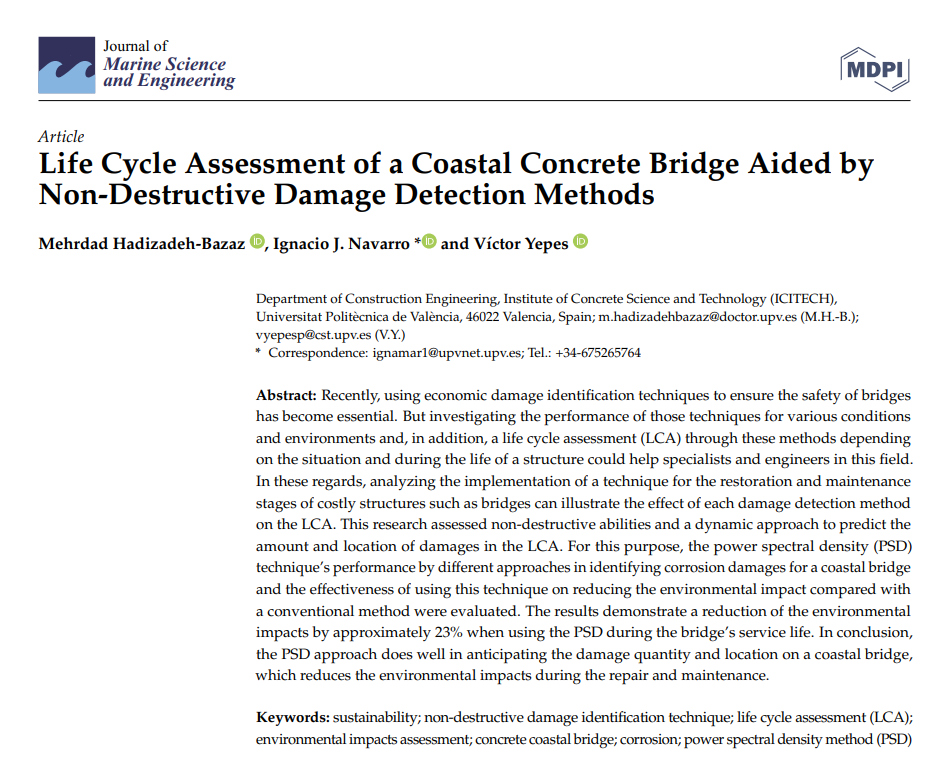 Acaban de publicarnos un artículo en el Journal of Marine Science and Engineering, revista indexada en el JCR. Se trata de la evaluación del coste del ciclo de vida con ayuda de métodos no destructivos de un puente de hormigón en ambiente costero. El trabajo se enmarca dentro del proyecto de investigación HYDELIFE que dirijo como investigador principal en la Universitat Politècnica de València.
Acaban de publicarnos un artículo en el Journal of Marine Science and Engineering, revista indexada en el JCR. Se trata de la evaluación del coste del ciclo de vida con ayuda de métodos no destructivos de un puente de hormigón en ambiente costero. El trabajo se enmarca dentro del proyecto de investigación HYDELIFE que dirijo como investigador principal en la Universitat Politècnica de València.
-
El artículo evalúa el uso de métodos no destructivos de detección de daños, específicamente la técnica de densidad espectral de potencia (PSD), para reducir el impacto ambiental durante la reparación y el mantenimiento de un puente costero de hormigón. Los resultados muestran una reducción del 23% en los impactos ambientales cuando se utiliza el enfoque PSD durante la vida útil del puente.
-
La investigación evalúa las capacidades no destructivas y el enfoque dinámico de la técnica PSD para predecir la cantidad y la ubicación de los daños en la evaluación del ciclo de vida (LCA) del puente. Esta evaluación ayuda a los especialistas e ingenieros en el campo de la seguridad y el mantenimiento de los puentes.
Abstract:
Recently, using economic damage identification techniques to ensure the safety of bridges has become essential. But investigating the performance of those techniques for various conditions and environments and, in addition, a life cycle assessment (LCA) through these methods depending on the situation and during the life of a structure could help specialists and engineers in this field. In these regards, analyzing the implementation of a technique for the restoration and maintenance stages of costly structures such as bridges can illustrate the effect of each damage detection method on the LCA. This research assessed non-destructive abilities and a dynamic approach to predict the amount and location of damages in the LCA. For this purpose, the power spectral density (PSD) technique’s performance by different approaches in identifying corrosion damages for a coastal bridge and the effectiveness of using this technique on reducing the environmental impact compared with a conventional method were evaluated. The results demonstrate a reduction of the environmental impacts by approximately 23% when using the PSD during the bridge’s service life. In conclusion, the PSD approach does well in anticipating the damage quantity and location on a coastal bridge, which reduces the environmental impacts during the repair and maintenance.
Keywords:
Sustainability; non-destructive damage identification technique; life cycle assessment (LCA); environmental impacts assessment; concrete coastal bridge; corrosion; power spectral density method (PSD)
Reference:
HADIZADEH-BAZAZ, M.; NAVARRO, I.J.; YEPES, V. (2023). Life Cycle Assessment of a Coastal Concrete Bridge Aided by Non-Destructive Damage Detection Methods. Journal of Marine Science and Engineering, 11(9):1656. DOI:10.3390/jmse11091656
